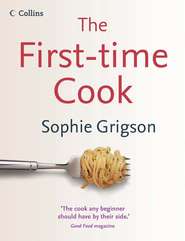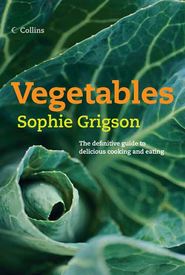По всем вопросам обращайтесь на: info@litportal.ru
(©) 2003-2024.
✖
The Student Cookbook
Настройки чтения
Размер шрифта
Высота строк
Поля
need to know
STORING STOCK Stock will keep for two days in the fridge. If you want to keep it for longer than that, pour it into a wide, deep frying pan and boil down until reduced in volume by about two-thirds. Cool, and then pour carefully into ice-cube trays. Freeze, and then store your own home-made frozen stock cubes in an airtight container in the freezer. When you come to use them, melt and dilute with water to taste, to restore your stock to its original state.
Machinery
If you like smooth soups, then you will need to invest in some type of liquidiser. Jug liquidisers are surprisingly cheap and make a far smoother soup than a processor, which is far more expensive anyway. Hand-held wand liquidisers are also a bargain. Although it takes longer to liquidise a saucepanful of soup, you have a greater degree of control, so that if you wish you can vary the texture from rough and chunky to silky smooth.
Before liquidising, let the soup cool a little, so that odd splashes won’t burn you. With a jug liquidiser, always make sure that the lid is firmly clamped on. Don’t overfill – it is better to liquidise the soup in three or four batches, than to risk it squirting out all over the kitchen.
Even the toughest liquidiser can’t reduce absolutely everything to a smooth cream, so every now and then you will come across a soup that also needs sieving (such as the roast tomato and onion soup on page 24). The trick here is to make sure that you have a sieve with a comparatively loose mesh, i.e. with big enough holes to make sieving bearable. A sieve with a very tight mesh is fine for, say, sifting flour, but a nightmare when it comes to soups and sauces, as you have to work really, really hard for relatively small returns. So, go check your sieves and if necessary invest in a new, wide-meshed one as soon as possible. With that in hand, sieving a soup should be an easy enough matter. Use the largest wooden spoon you own to push the solids through the mesh of the sieve, scraping the puréed matter that clings to the underside off into the rest of the soup fairly frequently.
Alternatively, you could buy a mouli-légumes, or a food mill, which will do a similar job with efficiency.
Thinning Down
Once your soup is liquidised, you can assess the consistency properly. You may like it just as it is, but if you want to thin it down to a lighter consistency, stir in a little water if it needs only minor adjustment, or more stock, or perhaps some milk, if appropriate. Add a little at a time, stir in and then taste. Be careful not to overdo the extra liquid, or you will end up with a soup that tastes of precious little at all.
Dressing Up
An unadorned naked bowl of soup is a fine thing in itself, but there are times when all of us, soup included, benefit from a spot of dressing up. Some garnishes go particularly well with specific soups, whilst others are universally a good thing. Here is a list of some of the best, to be used on their own or in tandem with others
Fresh herbs Shredded basil leaves on any tomato-based soup; coriander leaves on soups with a hint of spice; chopped parsley or chives will give a lift to most soups; tarragon leaves bring a hint of aniseed – use your imagination.
Cream A drizzle or swirl of cream looks classy and enriches soup. It doesn’t matter a great deal whether it is single, whipping or double cream. Lightly whipped cream, seasoned with lime juice or herbs, floats on top of the soup, melting gently in the heat. Soured cream, crème fraîche and yoghurt (especially Greek-style yoghurt) need to be dolloped on gently. Yoghurt has a tendency to sink.
Croûtons The traditional croûton is a small, crisp golden cube of fried bread which adds a welcome contrast in texture to most soups. I find it easier to bake croûtons in the oven: toss cubed bread (crusts removed) with a little oil, turning well, then spread out on a baking sheet and bake at 190°C/375°F/Gas Mark 5, turning occasionally until golden brown, about 5-10 minutes. Although any decent loaf of bread will do, you can make extra-fancy croûtons with, say, olive bread or sun-dried tomato bread.
Croûtes Croûtes are larger versions of croûtons. Small slices of bread (either quarter large pieces, or use slices of a baguette) can either be toasted, or brushed with olive oil and baked in the oven until crisp (the best method, I think, see the croûtons section above). You could top each one with a smear of pesto (bought or home-made, see page 71), or tapenade (an olive and caper purée that can be bought in small jars from the deli). Or try a small swirl of crème fraîche, or you could pile some grated Gruyère cheese on top. Whatever you do, the idea is then to float it in the soup as it is served.
Cheese Grated or very finely diced cheese is a good garnish for chunky soups, such as the Italian vegetable and bean soup on page 26. Parmesan is wonderfully piquant, but grated mature Cheddar brings oodles of flavour, too. The sweetish, nutty taste of Gruyère is another winner.
Olive oil A drizzle of a really fruity extra virgin olive oil works well in many more Mediterranean soups, bringing a fresh, light richness that invigorates all the other flavours in the soup. For a powerful injection of energy, fry 1 or 2 chopped garlic cloves and a deseeded chopped red chilli in olive oil until the garlic is golden, then spoon over the surface of the soup, still hot and sizzling, just before serving.
Bacon Choose good-quality dry-cured streaky bacon (it crisps up better than back bacon), and cook in rashers until brown and crisp (see page 21).
Diced tomato, cucumber or pepper These add an appealing freshness to a soup, as well as a splash of colour. Deseed tomatoes and peppers, but don’t skin them, before dicing small. I really can’t see the point in deseeding cucumbers, but if you really want to, that’s fine. Diced celery can also work well, but a fair number of people aren’t so keen on it.
Good Vegetable Soup
This is a basic primer recipe for puréed vegetable soup. It’s ideal for using up the odds and ends of vegetables that gather in the bottom of the fridge or in the vegetable rack (as long as they are not too old and mouldering), but you can also use it to make a purer mono-veg soup, such as the curried parsnip soup below.
Serves 4-6
BASE INGREDIENTS
2 tablespoons olive or sunflower oil, or 30g (10z) butter
1 onion, peeled and chopped
1 garlic clove, peeled and chopped
AROMATICS
1 bouquet garni (the classic one below)
and/or 1-2 fresh red chillies, deseeded and chopped
or 1 teaspoon or more curry paste or curry powder or spices, e.g. cumin, fennel seeds, cinnamon, etc.
MAIN INGREDIENTS
1 potato, or other thickener if needed, peeled and cut into chunks
500g(18oz)vegetables, prepared as appropriate (see page 27) and roughly chopped
LIQUID
1-1.5 litres (13/4-23/4 pints) Vegetable or Chicken Stock (see pages 15-17), or vegetable cooking water, or a mixture of water and milk
SEASONINGS
salt and pepper
1 Heat the oil or butter gently in a large saucepan, then add the base ingredients, the aromatics and the main ingredients. Stir around to coat everything in the fat, then sweat very gently for 10-15 minutes.
2 Add the smaller amount of stock or other liquid, saving the rest for thinning down (if necessary), and season with salt and pepper. Bring up to the boil, then simmer gently for about 20 minutes until all the vegetables are tender.
3 Liquidise in several batches, and return to the pan. Thin down with the reserved stock, water or milk as required, and check the seasoning.
4 Reheat when needed, and eat.
need to know
BOUQUET GARNI This is a bundle of herbs, that gives flavour to stocks, soups and stews. Classically it is a bay leaf, a sprig of parsley and a sprig of thy me tied together with string. Other flavours can be added – leek leaves, alternative herbs or lemon zest.
Potato, Parsley and Garlic Soup
This yummy, comforting soup can be served as a first course, or in larger quantities whenever you are need of a bit of inner warmth. I love it with a touch of cheese and some crisp, salty bacon bits stirred in, but neither is utterly essential. You might just want to scatter over a few chopped chives instead, or spoon on some nuggets of golden-fried chopped garlic and chilli with a drizzle of olive oil.
Serves 4-6
BASE INGREDIENTS
1 onion, peeled and chopped
30g (10z) butter
AROMATICS







